Starmus, day 2: Saturn's rings and the great memory of the rats
Starmus, Tenerife's astrophysics conference I spoke about in the previous post, is a stellar event, quantum celestial! I do not remember a conference where he did not attend and devoured every single presentation, from beginning to end. However, here it was just so (or almost). Interesting, brilliant, captivating, stimulating, in a nutshell: out of the world, exactly like the subject matter.
OK, let's move on to a brief summary of the presentations of the second day!
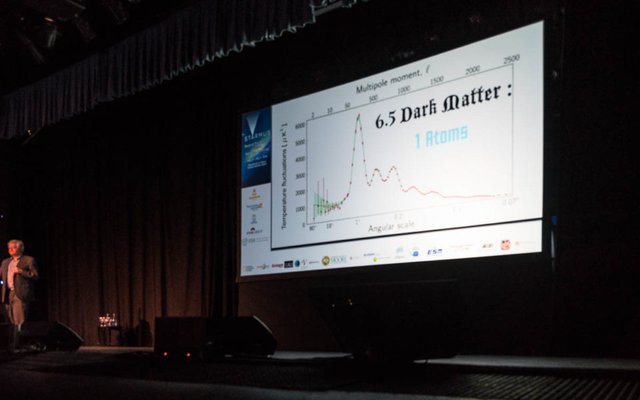
He is an Australian naturalized American astrophysicist and Nobel Prize winner for physics in 2011. His interesting presentation, which gave much to reflect, focused on the dark matter with which, according to the scientist, a large part of the universe would be composed, but which we cannot see either with the naked eye or with special microscopes. Moreover, he told us about dark energy (doesn't it seem like a subgenre of techno music?:), which, besides being completely unknown and invisible, is thought to permeate the whole space (according to Wikipedia).
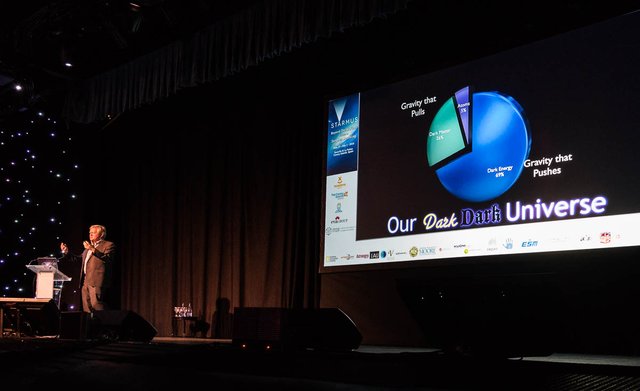
The galaxies rotate, the Universe expands: it's as if there were both dark matter (unknown) and energy at stake. But although it constitutes 95% of the composition of the Universe we can't see it! In other words, everything we can observe around us represents only 5% of all that is out there, i. e. only 5% of the matter and energy of the Universe. What?
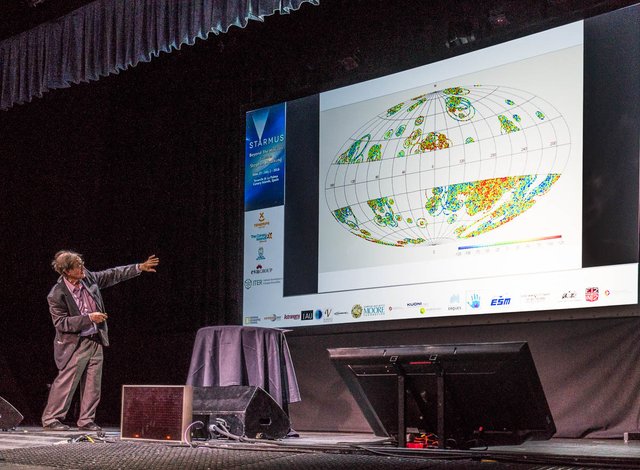
Sir Roger Penrose.
British physicist, mathematician and philosopher (finally a non-North American scientist). His presentation was really vintage: to project his slides he used an old projector of those that work with transparencies. Things of the past! However, the presentation was very interesting, the transparencies were changed by hand and the physicist also used a marker pen.
Roger Penrose made hypotheses about what could have happened during and before the Big Bang. That the time has come to unveil this mystery based for the moment only on signs and waves left in the Universe? Were there life forms before the Big Bang? If so, what were they? A theory that makes us reflect, so fascinating that I have carved it in my memory so that we can reflect on it later.
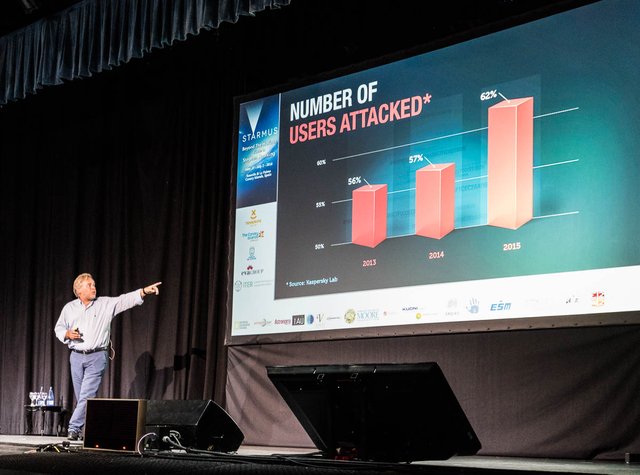
Neil deGrasse Tyson.
American Astrophysicist. An exceptional speaker. He told us the opinion of scientists about potential third type meetings. Of course, reaching the stars (which would undoubtedly require vehicles with a great speed like the one that reaches the Millennium Falcon of "Star Wars") is undoubtedly a dream still very far away. However, everyone thinks so, not only science fiction writers, but scientists as well. According to the latter, it will take a long time before other forms of life are noticed or realised (in the same way that we don't realize worms or they don't realize us). Or they will find us as adorable as we are adorable kittens. What they will not do - the expert warns us - is to hurt us. Meanwhile, I was wondering: is this person an extra-terrestrial agent? He might have come here so far to calm our fears about the invading aliens, wait until we take down the guard and then attack us....
Me!
I wasn't there just to attend the presentations (although it would have been nice too). I too gave my own presentation and was called "Dark Ages of Cybersecurity". Practically it was about how we need to save cybersecurity from itself, thinking differently. They told me that it was smooth and very much liked. Fiuh.... all smooth!
David Zambuka.
It needs no comment!
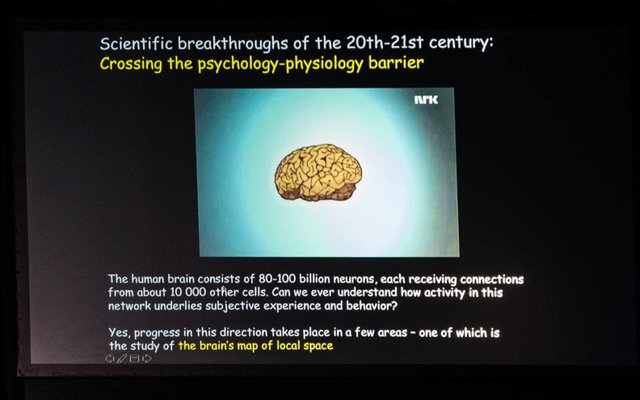
Edvard Moser.
Norwegian psychologist and neuro-scientist. Nobel Prize for Psychology or Medicine in 2014. This presentation focused entirely on the brain and how science in this area is advancing.
Apparently rats have a very advanced brain. Scientists managed to insert small sensors into their brain, sensors that were able to measure changes at the neuronal level. Then they made him do the usual things: run in the cage, etc.. And they recorded the results.
The first neuron (or area of neurons) to be recorded only released impulses if the rats were in a specific location. Then they created a map with these places and got a sort of grid.

In other words, a rat's mind is able to determine the location of a particular rat. And with additional stimuli, they discovered other areas of the brain that reacted to localization but on a different scale.
With additional stimuli (see photo) we arrive at Figure 1.42 which is the scale of distance measurement for the brain of that rat.
Then they managed to analyze some areas of the neuronal network of rats' thoughts, and were able to determine the direction and speed of movement, and contact with familiar objects (such as walls).
In other words, rats have a GPS embedded within their minds. If a rat goes down a road once, it will certainly remember it. Confirmed with experiments!
But not only do rats have a GPS in their brains; similar systems have been tracked in the minds of bats, monkeys and even (Darwin forgive me!) in humans.
Among other things, some experiments were carried out on humans totally in the fifties style. Take a look at the photo:
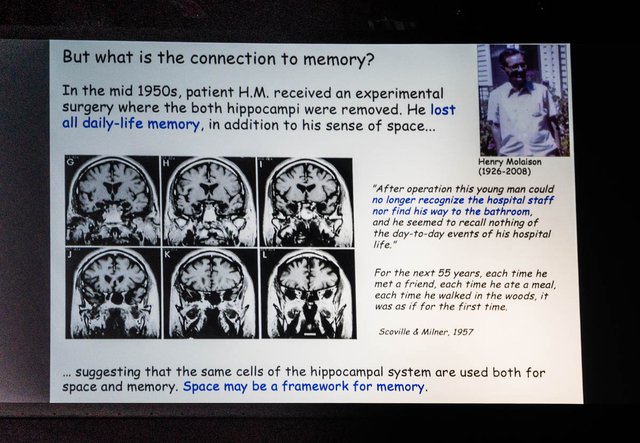
Then there was another, much more precise research. In a nutshell, our brains are memory cells connected to thousands of other cells. This works in two dimensions:
Would you like to know more? Study science! It will help you fight against your chronic dissatisfaction, feeling at the margin or other stupid ideas (if that's what you are suffering from). Too late? (although I say it is never too late). At the very least let your children study a little science.
Carolyn Porco.

American scientist and leader of the imaging science team on the interplanetary mission Cassini launched to study the Saturn system.
The photos are.... (long siletium pause). Take a look at yourself!
Saturn's rings are flat discs, several kilometres wide, smooth and luminous. And along the edges there is a high-pressure area of 2-3 kilometres. Virtually everything has been photographed, even the smallest astral object of what is called Earth. These photos were not the clearest, but what is certain is that it is our planet.
Next: the astronauts Alexei Leonov, Rusty Schweickart, Claude Nicollier, Sergey Volkov, Garrett Reisman, Roman Roman Romanenko. Moderator: Chris Hadfield (all search for them on Google). A lot of interesting things about past missions have emerged, but unfortunately little has been said about the future.
This ends on the second day.... but not the evening! All on buses to the psychedelic party organized at ITER, the institute for renewable energy.

For now it's all! Tomorrow, tomorrow with the third appointment and the final episode, again here, by Starmus....
Very good post,
I just use steemit not know how can get upvote from all friend,
I apologize if there is a word I am wrong,
Hopefully this becomes a friend like in the real world,
I am still studying here friend
Hopefully I can get information and motivation from you,
my future will always follow you
All the steemian greetings